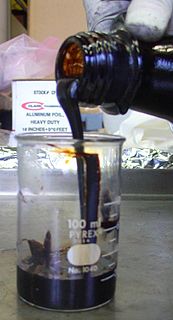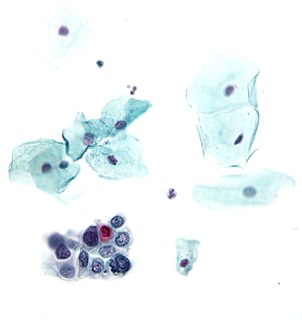Coal tar is a thick dark liquid which is a by-product of the production of coke and coal gas from coal. It has both medical and industrial uses. It may be applied to the affected area to treat psoriasis and seborrheic dermatitis (dandruff). It may be used in combination with ultraviolet light therapy. Industrially it is a railway tie preservative and used in the surfacing of roads.

In organic chemistry, a hydrocarbon is an organic compound consisting entirely of hydrogen and carbon. Hydrocarbons are examples of group 14 hydrides. Hydrocarbons from which one hydrogen atom has been removed are functional groups called hydrocarbyls. Because carbon has 4 electrons in its outermost shell carbon has exactly four bonds to make, and is only stable if all 4 of these bonds are used.
Naphtha is a flammable liquid hydrocarbon mixture.
Coal gas is a flammable gaseous fuel made from coal and supplied to the user via a piped distribution system. It is produced when coal is heated strongly in the absence of air. Town gas is a more general term referring to manufactured gaseous fuels produced for sale to consumers and municipalities.
Keratosis pilaris (KP) is a common, autosomal dominant, genetic condition of the skin's hair follicles characterized by the appearance of possibly itchy, small, gooseflesh-like bumps, with varying degrees of reddening or inflammation. It most often appears on the outer sides of the upper arms,, thighs, face, back, and buttocks; KP can also occur on the hands, and tops of legs, sides, or any body part except glabrous (hairless) skin. Often the lesions can appear on the face, which may be mistaken for acne.

A seborrheic keratosis is a non-cancerous (benign) skin tumour that originates from cells in the outer layer of the skin. Like liver spots, seborrheic keratoses are seen more often as people age.

Acenaphthene is a polycyclic aromatic hydrocarbon (PAH) consisting of naphthalene with an ethylene bridge connecting positions 1 and 8. It is a colourless solid. Coal tar consists of about 0.3% of this compound.

Tar is a dark brown or black viscous liquid of hydrocarbons and free carbon, obtained from a wide variety of organic materials through destructive distillation. Tar can be produced from coal, wood, petroleum, or peat. Production and trade in pine-derived tar was a major contributor in the economies of Northern Europe and Colonial America. Its main use was in preserving wooden sailing vessels against rot. The largest user was the Royal Navy of the United Kingdom. Demand for tar declined with the advent of iron and steel ships.

Picene is a hydrocarbon found in the pitchy residue obtained in the distillation of peat tar and of petroleum. This is distilled to dryness and the distillate repeatedly recrystallized from cymene. It may be synthetically prepared by the action of anhydrous aluminium chloride on a mixture of naphthalene and 1,2-dibromoethane, or by distilling a-dinaphthostilbene. It crystallizes in large colorless plates which possess a blue fluorescence. It is soluble in concentrated sulfuric acid with a green color. Chromic acid in glacial acetic acid solution oxidizes it to picene-quinone, picene-quinone carboxylic acid, and finally to phthalic acid.

Fluoranthene is a polycyclic aromatic hydrocarbon (PAH). The molecule can be viewed as the fusion of naphthalene and benzene unit connected by a five-membered ring. Although samples are often pale yellow, the compound is colorless. It is soluble in nonpolar organic solvents. It is a member of the class of PAHs known as non-alternant PAHs because it has rings other than those with six carbon atoms. It is a structural isomer of the alternant PAH pyrene. It is not as thermodynamically stable as pyrene. Its name is derived from its fluorescence under UV light.
Stomatitis nicotina, is a diffuse white patch on the hard palate, usually caused by tobacco smoking, usually pipe or cigar smoking. It is painless, and it is caused by a response of the palatal oral mucosa to chronic heat. A more pronounced appearance can occur with reverse smoking, sometimes distinguished from stomatitis nicotina by the term reverse smoker's keratosis. While stomatitis nicotina that is caused by heat is not a premaligant condition, the condition that is caused by reverse smoking is premalignant.
Occupational acne is caused by several different groups of industrial compounds, including coal tar derivatives, insoluble cutting oils, and chlorinated hydrocarbons.
Keratosis pilaris atropicans includes many forms of keratosis pilaris with cicatricial alopecia. Variants include keratosis pilaris atrophicans faciei, atrophoderma vermiculatum, keratosis follicularis spinulosa decalvans, and ichthyosis follicularis.
Keratosis follicularis spinulosa decalvans is a rare X-linked disorder described by Siemens in 1926, a disease that begins in infancy with keratosis pilaris localized on the face, then evolves to more diffuse involvement.
Common seborrheic keratosis is a common benign cutaneous condition characterized by a skin lesion with a dull or lackluster surface.
Reticulated seborrheic keratosis is a common benign cutaneous condition characterized by a skin lesion with a dull or lackluster surface, and with keratin cysts seen histologically.
A stucco keratosis is a common benign skin condition characterized by a lesion with a dull or lackluster surface, and with church-spire-like projections of epidermal cells around collagen seen histologically. Stucco keratoses are often light brown to off-white, and are no larger than a few millimeters in diameter. They are often found on the distal tibia, ankle, and foot.

Inverted follicular keratosis is a skin condition characterized by asymptomatic, firm, white–tan to pink papules and considered as a subtype of seborrheic keratosis.








